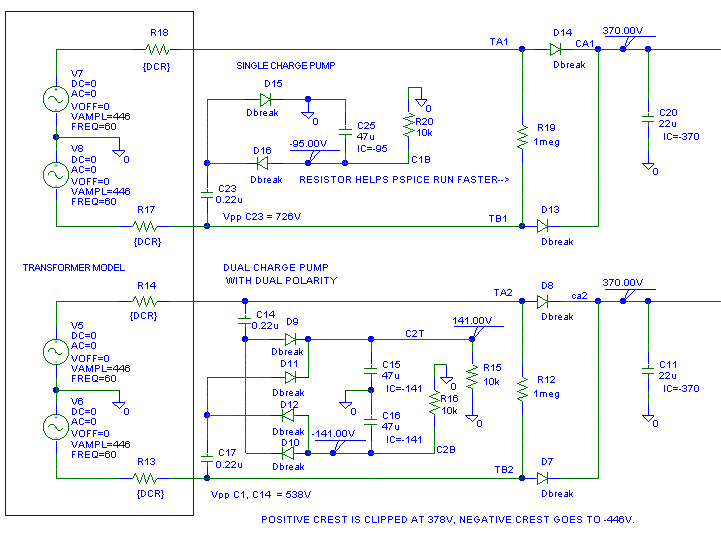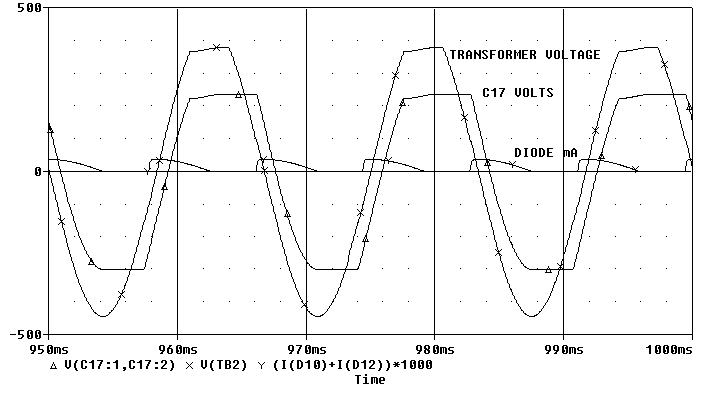
This trick for making a supply voltage is not recommended
for beginners.
This is an example only, it has not been tested!
This involves working with high voltages,
attempt this at your own risk.
Added 12/30/00 Updated 12/30/00
Each cycle of the line voltage a charge pump transfers a charge equal to:
Q = C * delta in voltage on capacitorThe current from the charge pump is:
I = Q * line frequencyThe difficulty in using charge pumps is determining the "delta in voltage on the capacitor". This is because
I = C * delta in voltage on cap * 60 Hz
1. The crest of the sine wave coming from the wall socket is seldom the crest factor (1.414) times the RMS voltage.
2. The crest of the sine wave coming from the transformer can be distorted if it is rectified to make normal output voltage.
3. The line voltage at the equipment can vary 10% or more.
For example:Because the charge pump "sort of" behaves like a current source, you must make sure that the output capacitor always has a load on it. The best way to do this is to put a power zener across the capacitor. The power zener should be rated for full output current.I1 = 0.22 uF * 60 Hz * (370V + 446V - 95V)
I1 = 0.22 uF * 60 Hz * (721V) Pspice gave 726 V delta V because it
included the ripple of the output
capacitors and the drops of the diodes.
I1 = 9.5 mAI2 = 0.22 uF * 2 * 60 Hz * (370V + 446V - 2 * 141V)
I2 = 0.22 uF * 120 Hz * (534V)
I2 = 14.1 mA
What happens if the output is unloaded? The output rises to be equal to the available peak to peak voltage from the charge pump capacitor. If the capacitor and parts on the output can't handle this voltage, they will fail (sometimes they can fail violently.)Because the current varies with line voltage, the charge pump must be designed at low line and at a low crest factor (say 1.30 instead of 1.414). This also means that the power zener will have to clamp the extra current at high line.Some protection against the charge pump capacitor failing short should also be considered.
The charge pump capacitor voltage must be rated for more than the high line, unloaded, peak to peak voltage out of the transformer. This may require using two capacitors in series with a balancing resistor.
Here are two examples of charge pumps. The top one is a single ended pump. The bottom one uses two pumps so that the effective frequency is 120 Hz for the 0.22 uF capacitor. The bottom one also makes a + and - supply. The zener output clamps and charge pump fuse are not shown because I did not have suitable models in my Pspice library.
A schematic showing two untested charge pumps
Added 12/30/00 Updated 12/30/00
I prefer to think of the dual charge pump as doubling the frequency instead of doubling the capacitance because the ripple on the output voltage will be at 120 Hz, not 60 Hz, when a dual charge pump is used.

Here is what a couple of the critical voltages look like on the dual charge pump. The diode currents into the negative rail capacitor are shown to help you understand what is happening. The dual charge pump is providing 14 mA into 141V under these line conditions.

Because the current flow from the charge pumps is usually out of phase with the current that normally flows through the transformer into the main (370V) output capacitor, the transformer sees an RMS current of
I_rms_total = SQRT( I_rms_main^2 + I_rms_chg_pump^2 )
instead of
I_rms_total = I_rms_main + I_rms_chg_pump <-- Remember, don't use this equation!
This allows us to pull a good amount of current from the charge pump with out adding a lot of heat to the mains transformer.
In the example above:
The single charge pump increased the RMS transformer secondary current from 70.5 mA to 74.9 mA on the winding with the charge pump and no change on the other winding.
The dual charge pump increased the RMS transformer current on both secondaries from 70.5 mA to 74.0 mA.Transorbs that can be used as zeners:I ran one more run on the dual charge pump with the charge pump unloaded and 28 mA added to the 370 V B+ and the RMS transformer secondary current increased from 70.5 mA to 98.5 mA! I am amazed the change on the winding was not more than 28 mA because of the power factor of the capacitive input filter.
The smaller transorb (84K pdf file).
The bigger transorb (98k pdf file).
Mouser page for transorbs (71k pdf file).